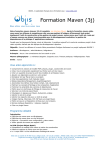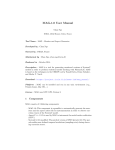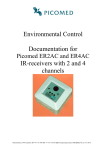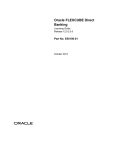Download cmvn - Configured Maven User Manual
Transcript
cmvn - Configured Maven User Manual
Tobias Roeser
Version 0.0.5
1
Contents
1. Introduction
3
2. Execution Modes
2.1. Configuration . . . . . . . . . . . .
2.1.1. Automatic re-configuration
2.1.2. Maven Settings . . . . . .
2.2. Build . . . . . . . . . . . . . . . .
2.3. Cleanup . . . . . . . . . . . . . .
3. The
3.1.
3.2.
3.3.
3.4.
3.5.
configuration file cmvn.conf
Config file syntax . . . . . . . .
Config file example . . . . . . .
Legend . . . . . . . . . . . . .
Directives . . . . . . . . . . . .
Settings . . . . . . . . . . . .
3.5.1. project . . . . . . . .
3.5.2. module . . . . . . . . .
3.5.3. dependency . . . . . .
3.5.4. property . . . . . . .
3.5.5. repository . . . . . .
3.5.6. plugin . . . . . . . . .
3.5.7. build . . . . . . . . .
.
.
.
.
.
.
.
.
.
.
.
.
.
.
.
.
.
.
.
.
.
.
.
.
.
.
.
.
.
.
.
.
.
.
.
.
.
.
.
.
.
.
.
.
.
.
.
.
.
.
.
.
.
.
.
.
.
.
.
.
.
.
.
.
.
.
.
.
.
.
.
.
.
.
.
.
.
.
.
.
.
.
.
.
.
.
.
.
.
.
.
.
.
.
.
.
.
.
.
.
.
.
.
.
.
.
.
.
.
.
.
.
.
.
.
.
.
.
.
.
.
.
.
.
.
.
.
.
.
.
.
.
.
.
3
4
4
4
5
5
.
.
.
.
.
.
.
.
.
.
.
.
.
.
.
.
.
.
.
.
.
.
.
.
.
.
.
.
.
.
.
.
.
.
.
.
.
.
.
.
.
.
.
.
.
.
.
.
.
.
.
.
.
.
.
.
.
.
.
.
.
.
.
.
.
.
.
.
.
.
.
.
.
.
.
.
.
.
.
.
.
.
.
.
.
.
.
.
.
.
.
.
.
.
.
.
.
.
.
.
.
.
.
.
.
.
.
.
.
.
.
.
.
.
.
.
.
.
.
.
.
.
.
.
.
.
.
.
.
.
.
.
.
.
.
.
.
.
.
.
.
.
.
.
.
.
.
.
.
.
.
.
.
.
.
.
.
.
.
.
.
.
.
.
.
.
.
.
.
.
.
.
.
.
.
.
.
.
.
.
.
.
.
.
.
.
.
.
.
.
.
.
.
.
.
.
.
.
.
.
.
.
.
.
.
.
.
.
.
.
.
.
.
.
.
.
.
.
.
.
.
.
.
.
.
.
.
.
.
.
.
.
.
.
.
.
.
.
.
.
.
.
.
.
.
.
.
.
.
.
.
.
.
.
.
.
.
.
.
.
.
.
.
.
6
6
6
7
7
7
8
8
9
9
10
10
10
4. Terms of Use (License)
11
A. Shell Wrapper
12
B. Command Shell Wrapper (Windows)
12
2
1. Introduction
cmvn is a helper tool for developers targeted at the Java Virtual Machine (JVM). Its main
focus is to declaratively describe and configure the required development and build environment.
A most significant difference between Java-targeted build systems compared to those for
C/C++1 is the lack of a defined configuration step before executing the compiler. Although
building a Java application is a lot more easy compared to platform dependent programming
languages and tools, nevertheless a lot of the (configuration) tasks of those other build
systems are still required. Often the lack of a configuration process in Java build systems
results in very obscure setups.
A very popular build system for Java is Apache Maven2 , currently in version 3. It partially
helps the developer with managing her dependencies but fails miserably at producing reliable
builds, at least without support of a complex build infrastructure.3
cmvn tries to close this gap by providing a configuration step before the actual build system. Concrete, this goal will be reached by generating the build scripts for the underlying
(nativ) build system. Whenever a configuration has changed cmvn will first regenerate the
build scripts and after that executes the underlying build system with the right (configured)
settings. To assist the developer but do not stay in his way, cmvn does not aim to replace
existing build chains. Instead, its main focus is adding another (first) configuration step to
the build chain to create more reliable and reproducable build environments.
In its first release cmvn supports Apache Maven 2.0 and above4 . In later releases support for
various other build chains will be added, e.g. Apache Ant + Ivy, SBT, JackBuild, or others.
Although cmvn generates the build scripts (in Maven case: pom.xml files) is does not can
and it wants not handle all aspects of the underlying build infrastructure. To leave the full
power to the developer, cmvn supports templates for the underlying build scripts for those
settings cmvn can not generate. But for common project setup, this is rarely needed.
2. Execution Modes
cmvn can be run in different execution modes:
. Configuration
. Build
. Cleanup
1
e.g. Autotools + GNU Make, CMake, Scons.
http://maven.apache.org
3
...like a Repository Manager.
4
Using Apache Maven 3.0 is highly recommended.
2
3
The execution mode is given as (first) parameter when executing cmvn.
2.1. Configuration
Simplest Example:
shell > cmvn -- configure
Just generate the needed build scripts (if needed) of the underlying buildsystem.
For Maven this generates a pom.xml and a Maven settings file .cmvn/settings.xml in a
local hidden directory.
2.1.1. Automatic re-configuration
To reconfigure an already configured project, e.g. because the cmvn config file has changed
or a generated file is missing, one can use the option –reconfigure which does exactly the
same as –configure except that the concrete initial configuration is preserved, thus only
the files were recreated without changing the current configuration.
shell > cmvn -- reconfigure
If cmvn detects, that the current project is not up-to-date, it must be used with
–reconfigure. To avoid the burden of beeing forced to run a cmvn –reconfigure after
each change of the project (or sub project) configuration, the option –auto-reconfigure
can be used together with –configure.
shell > cmvn -- configure -- auto - reconfigure
Configured that way, cmvn will automatically reconfigure the project (and the whole project
tree) before a build, if needed.
2.1.2. Maven Settings
By default, cmvn –configure initally created an new project-local Maven settings file and
thus uses a project-local repository. This is intended to isolate projects from each other
while still maintaining project-interoperability via (remotely) realeased dependencies. This
default way enables the developer to easy build branches without fearing of interferences and
inconsistencies caused by multiple projects (branches) that are releasing to the same local
repository.
Of course, the newly created repository and Maven settings file is shared between all sub
projects of the one you just configured.
4
In case, this default behavior is not desired, you can tell cmvn to use an alternative existing
Maven settings file with the option –maven-settings. In this case, you may will loose the
benefits of side-effect free development of multiple project on the same computer. Also this
may limit the reproducability of the build process in different environments.
shell > cmvn -- configure -- maven - settings =/ home / user /. m2 / settings . xml
Notice, that if you use an alternative Maven settings file, cmvn will not touch this file and
the Local Maven Repository when running in cleanup execution mode.
2.2. Build
Maven Example: Clean project build and install the build jar file into the local Maven
repository.
shell > cmvn -- build clean install
The build execution mode is automatically enabled if no other mode was requested and at
least one non-option argument was given to cmvn. So the example above could also be
written as:
shell > cmvn clean install
If cmvn is run without any option and parameter but the project was configured with
the reconfigure-option, all necessary project files will be regenerated automatically if
needed.5
2.3. Cleanup
The execution mode cleanup is used to remove all generated files and the configuration
data. Currently there are two variants to enable the cleanup mode: one version enabled
with –clean removes only the generated native build scripts, the other variant –distclean
cleans also the configuration state and any other generated environment setup, e.g. a hidden
project local Maven repository.
shell > cmvn -- clean
Cleans up all generated native build scripts.
shell > cmvn -- distclean
Cleans up all generated files including configured state.
5
Without the auto-reconfigure setting the same behavior can be achieved by running cmvn
–reconfigure.
5
3. The configuration file cmvn.conf
3.1. Config file syntax
The config file has a very simplistic human readable and editable format:
1. empty lines were ignored
2. the hash sign (#) starts a comment until end of line
3. each non-comment line consists of a pair of key and value delimited by a colon (:)
4. keys starting with a hyphen (−) are directives all other keys were settings
5. values may have options, in which case options are separated by a semicolon (;)
6. value-options are themselves key-value pairs delimited by equal sign (=)
7. if an option-value is ommitted (an option without an equal sign) it is evaluated to
’true’
8. non-comment lines ending with a backslash (\) were continued on the next line
3.2. Config file example
The following is an example project config file cmvn.conf:
# Include directive
- include : ../ common / cmvncommon . conf
# Immutable variable directive
- val : EXAMPLE_VERSION =0.0.1
# project settings using a variable
# cmvn uses a short syntax for projects and dependencies
# group : artifact : version ( GAV ) or org : name : rev
project : de . tototec : de . tototec . example : $$ { EXAMPLE_VERSION }
# a dependency with option spreading two lines
compile : de . tototec : de . tototec . example . utils : $$ { EXAMPLE_VERSION }; \
classifier = jdk15
# compile - scope dependency
compile : org . slf4j : slf4j - api :1.6.1
# optional runtime - dependency
runtime : ch . qos . logback : logback - classic :0.9.26; optional
# test - scope dependency
test : org . testng : testng :5.14.6
6
3.3. Legend
The following sections contain tables with uses the following keyword in the format column:
BOOLEAN
DIR
FILE
GAV
GA
LIST[X]
OPTION
TEXT
URL
XML
A boolean value: ’true’ or ’false’
A directory in the local file system
A file in the local file system
groupId:artifactId:version (analog to Maven) or org:name:rev (analog to Ivy)
Same as GAV, but without a version
A semicolon delimited list of X (if ommitted, than text)
A key =value pair
Text
A URL
A XML fragement
3.4. Directives
Directives are instructions to cmvn to do something special.
Directive
Format
-include FILE
-val
OPTION
Description
Include the content of the given file. The content will be threated
as if it was in the actual file.
Create an immutable variable key with content value. All occurences of this variable were expanded in the value-part of all
succeeding lines.
3.5. Settings
Settings are used to generate the underlying (native) build scripts. Currently the only supported buildsystem is Maven 2.
7
Setting
project
dependency
compile
Format
GAV
GAV
GAV
test
runtime
GAV
GAV
system
dependencyManagement
GAV
GAV
property
repository
repo
pluginrepo
OPTION
URL
URL
URL
artifactrepo
URL
module
plugin
build
DIR
GAV
LIST[OPTION]
Description
Project coordinates
A project/package dependency
Alias
for
dependency
with
option
scope=compile
Alias for dependency with option scope=test
Alias
for
dependency
with
option
scope=runtime
alias for dependency with option scope=system
Managed
dependency
in
dependencyManagement-block
Definition of property key with value value
Maven Repository
Alias for repository
Alias
for
repository
with
option
artifacts=false
Alias
for
repository
with
option
plugins=false
The path of a sub project
Maven plugin configuration
List of options for the <build>-block
3.5.1. project
Essential project information mandatory for Maven.
Format: GAV[;OPTION]*
Options:
Option
Format
packaging TEXT
Desciption
The packaging of the project, if ommitted, than ’jar’
3.5.2. module
Definition of a sub project.
Format: DIR[;OPTION]*
Options:
Option
Format
Desciption
skipCmvn BOOLEAN This sub project is a pure Maven project. Do not try to find a
cmvn.conf file.
skipEmvn BOOLEAN Alias for skipCmvn (for compatibility).
8
3.5.3. dependency
A dependency referencing a project in a Maven repository (in most cases a *.jar file).
Format: GAV[;OPTION]*
Options:
Option
scope
Format
TEXT
Desciption
The scope of the dependency. One of ’compile’, ’runtime’,
test’, system’ or ’provided’.
systemPath
TEXT
The local file path to the jar file. Only valid if scope is
system. In contrast to Maven specification, this path can
be also relative.
classifier
TEXT
The classifier, e.g. ’sources’.
type
TEXT
The type.
optional
BOOLEAN An optional dependency is not optional for the current
project but will be ignored in a transitive dependency resolution. (In an ideal world any compile type dependency
should be optional!)
exclude
GA
Excluded dependency from transitive resolved dependency
tree.
forceversion BOOLEAN Additionally the dependency will be added to the
<dependencyManagement>-block. This enforces the given
version and is somethimes an alternative to the exclude
option (and vice versa).
Aliases:
A
A
A
A
dependencyManagement A
compile
test
runtime
system
dependency with option scope=compile.
dependency with option scope=test.
dependency with option scope=runtime.
dependency with option scope=system.
managed dependency only in dependencyManagement-block.
3.5.4. property
Define a property in a <properties>-block.
Format: OPTION
9
3.5.5. repository
A remote Maven repository used to download dependencies.
Format: URL
Options:
Option
plugins
artifacts
releases
snapshots
Format
Desciption
BOOLEAN Can be used
BOOLEAN Can be used
BOOLEAN Can be used
BOOLEAN Can be used
to
to
to
to
download
download
download
download
Maven plugins (default: true).
Maven artifacts (default: true).
released dependencies.
snapshot dependencies.
Aliases:
repo
Same as repository.
pluginrepo
A repository with option artifacts=false.
artifactrepo A repository with option plugins=false.
3.5.6. plugin
A Maven plugin contribution to the Maven lifecycle.
Format: GAV
Options: Any option has the format OPTION and is added to the <configuration>-block
of the plugin definition.
Directives:
Directive
-extension
-execution
-xml:anyOption
Format
Desciption
BOOLEAN Specify if this plugin is a extensions-plugin (and thus e.g.
can contribute new project packaging types).
XML
A free XML fragement that will be placed inside the
<executions>-block of this plugin.
XML
Can be used if the option-value is XML and not text.
3.5.7. build
Redefine some project default settings.
Format: LIST[OPTION]
Options:
Option
Format
sources DIR
Desciption
The directory containing the source files.
10
4. Terms of Use (License)
cmvn is published under the Apache License, Version 2.0.
http://www.apache.org/licenses/LICENSE-2.0
11
A. Shell Wrapper
cmvn is distributed as executable jar including all its required dependencies.
For convenience, you may want to create a simple shell script cmvn as an executable wrapper
around the program:
Listing 1: Shell wrapper: mvu
# !/ bin / sh
# pass all arguments to cmvn with $@
exec java - jar cmvn - executable -0.1.0. jar $@
B. Command Shell Wrapper (Windows)
Listing 2: Windows Command Shell wrapper: cmvn.bat
: init
@REM Decide how to startup depending on the version of windows
@REM -- Windows NT with Novell Login
if " % OS % " == " WINNT " goto WinNTNovell
@REM -- Win98ME
if NOT " % OS % " == " Windows_NT " goto Win9xArg
: WinNTNovell
@REM -- 4 NT shell
if " % @eval [2+2] " == " 4 " goto 4 NTArgs
@REM -- Regular WinNT shell
set CM VN _C MD _L IN E_ ARG S =%*
goto endInit
@REM The 4 NT Shell from jp software
:4 NTArgs
set CM VN _C MD _L IN E_ ARG S =% $
goto endInit
: Win9xArg
@REM Slurp the command line arguments . This loop allows for an
unlimited number
@REM of agruments ( up to the command line limit , anyway ) .
set CM VN _C MD _L IN E_ ARG S =
: Win9xApp
if %1 a == a goto endInit
set CM VN _C MD _L IN E_ ARG S =% CM VN _C MD _L IN E_ AR GS % %1
12
shift
goto Win9xApp
@REM Reaching here means variables are defined and arguments have been
captured
: endInit
SET CMVN_JAVA_EXE = " % JAVA_HOME %\ bin \ java . exe "
% CMVN_JAVA_EXE % - jar cmvn - executable . jar % C MV N_ CM D_ LI NE _AR GS %
set CMVN_JAVA_EXE =
set CM VN _C MD _L IN E_ ARG S =
13


























